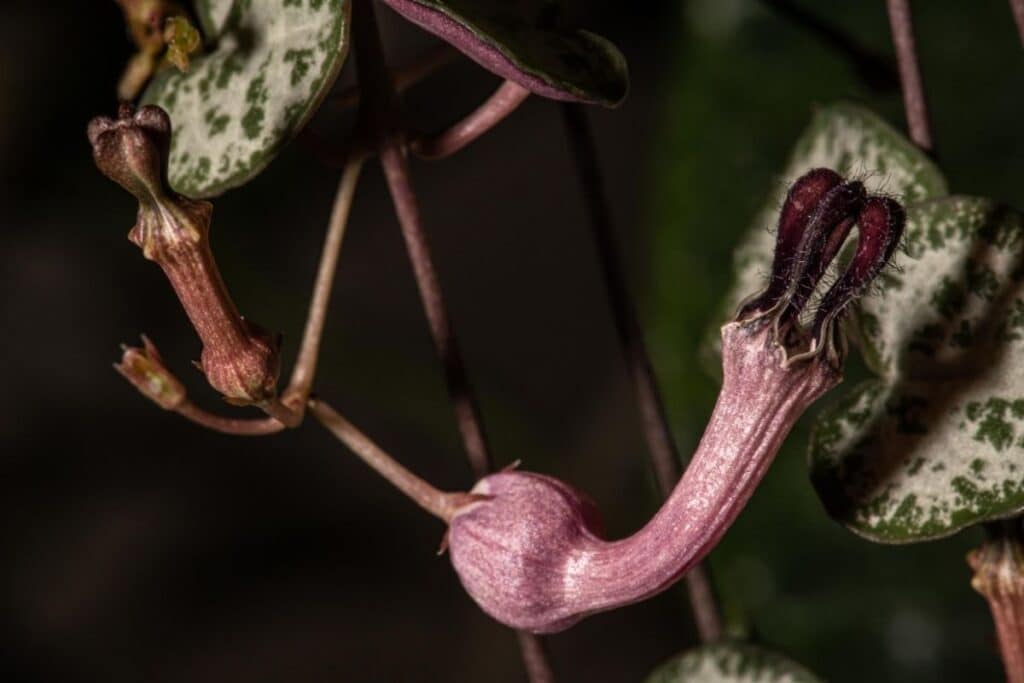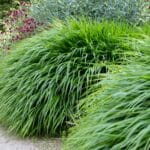One of the factors that makes a great house plant is the foliage. The leaves come in different forms and shapes and it seems that many growers today are drawn to plants with heart-shaped leaves.
The big-leafed alocassias and creeping pothos from the same family are popular but one dainty plant, the string of hearts, is making a name in the house plant scene. Read on to learn more about this delightful entanglement of a plant.
What is the String of Hearts?
Ceropegia linearis subsp. woodii is the formal name given to this plant by Carolus Linnaeus, describing the “fountain of wax” appearance of the flowers. More commonly known as string of hearts, other names include rosary vine, hearts entangled, sweetheart vine, and chain of hearts.
This evergreen plant is native to South Africa, Mozambique, Zimbabwe, and Eswantini, growing naturally on cliff edges and embedded in rock crevices (1).
A member of the dogbane family, thesse delicate vines have characteristically small heart-shaped dark green leaves with heavy white veins and purple-tinged margins. The Variegated String of Hearts have more pronounced markings on the leaves and brighter tinge.

These leaves initially grow close together but as the slender stems elongate, the leaves move further apart, enhancing the stringy appearance of the plant. This cascading growth is best appreciated when planted in a hanging pot.
Along the stems are nodes where small potato-like tubers may grow. They are a way for the plant to store food for regrowth as well as for reproduction. The tuber can produce new stems and roots and is one of the successful ways to propagate a string of hearts (1).
Throughout the year but mainly in summer and fall, the string of hearts produce odd but attractive flowers. They look like tiny purplish-white vases with long necks and sitting atop are downward-facing hair that traps insects helping the plant pollinate (2).
How to Grow and Care for String of Hearts
Light
Common in many types of house plants is their preference for bright indirect light and string of hearts is no different. Sudden exposure to strong light may cause sunburn so it is advisable to introduce bright filtered light gradually to avoid this.
The colors and markings on the leaves are darker and prominent with strong bright light and tend to lighten under shade. It is also important to note that while the string of hearts grow well in a semi-shaded condition, other growth factors such as watering should be modified to prevent problems.
Water
Ceropegia only requires average watering. The leaves are considered succulent, able to store enough moisture to keep the plant going so this plant can tolerate drought more than wet. Allowing the soil to dry in-between waterings is best for the string of hearts (3).
A well-draining soil is key to prevent its roots from standing water which does not only cause root rot but the infestation of woolly aphids as well (1).
Soggy soil can lead to root rot and other fungal diseases, so it’s important to ensure that the soil is well-draining and that the plant is not overwatered.
Drainage holes in the bottom of the pot are essential to allow excess water to escape and prevent the soil from becoming waterlogged.
Temperature and Humidity
String of hearts plants naturally grow in rocky areas of forests, so they prefer warm temperatures and humid conditions. Grow them indoors where temperature ranges between 25-30ºC.
The plant is not heat or frost tolerant so keep them from extreme temperatures. Mist it during hot summer days and when it goes dormant in winter, water the plant sparingly, making sure that the soil is completely dry before watering again (3).
Pests and Diseases
Aside from the occasional aphids, scale insect, and mealy bug attacks and the root rot disease, the string of hearts does not have a lot of pests and diseases. If there is a mild infestation, manual removal is enough or application of household grade insecticide.
Most of the time, these problems arise because of an improper watering practice so as much as possible, provide only the water required by the plant (2).
Propagation and Maintenance
Propagating Ceropegias is best done during summer, when the plant is in active growth stage. Aside from the underground tubers that can be divided, aerial tubers grow along the stem and if propagating using this method, it is recommended to allow the tuber to root first.
A tuber of about 2cm diameter is required. If the stem is long enough, there is no need to cut it right away. Just place the tuber on top of a sand-perlite potting mix in a separate pot and cover with a thin layer of fine sand (1).
With semi-shade and regular misting, feeder roots will develop within 8 weeks. Once the roots have established, the stem can be cut and the new plant will eventually grow new stems and leaves.
String of hearts grow 10cm high and up to 2m in spread. Propagate string of hearts by stem cutting can be done in time with pruning to make use of the pruned stems instead of discarding them.
Make sure that each cutting has several internodes and leave it submerged in water in a position where there’s good light and temperature.
After 2-4 weeks, roots should appear and wait for the stem cuttings to have established roots before potting (2). New growth should appear within a few weeks, indicating that the cutting has successfully rooted.
Matured string of hearts will benefit from fertilizer application once a month. They do not require much so feeding at half the recommended rate should be enough in order to avoid fertilizer burn.
Aside from hanging the succulent plant, a potted string of hearts can be placed on top of desks and cabinets where the stems can be allowed to drape from a height. The stems can also be wrapped on a sturdy structure and trained to climb. For full effect and since the plant likes it, let the string of hearts crowd in a pot.
FAQs
Why are string of hearts so expensive?
String of Hearts (Ceropegia woodii) can be relatively expensive due to its popularity and demand in the houseplant market, as well as its slow growth and propagation rate.
Is string of hearts hard to grow?
Yes, String of Hearts is generally considered easy to grow, making it suitable for both beginners and experienced plant enthusiasts. It thrives in well-draining soil, bright indirect light, and moderate watering.
Are string of hearts hard to keep alive?
No, String of Hearts is generally forgiving and not difficult to keep alive if provided with the right conditions. It’s important not to overwater, ensure proper drainage, and offer enough light for optimal health.
Is string of hearts rare?
While String of Hearts is not considered rare, its popularity may make it a bit challenging to find in certain locations. It has become a sought-after plant due to its unique trailing vines and heart-shaped leaves.
How do you make a string of hearts bushy?
To make a String of Hearts bushy, encourage lateral growth by pinching or pruning the tips of the vines. This stimulates branching, resulting in a fuller and more bushy appearance.
How do you know if a string of hearts is overwatered?
Overwatering can lead to yellowing and softening of the leaves in a String of Hearts. Signs of overwatering include mushy, translucent leaves and potential root rot. Allow the soil to dry out between waterings and adjust watering frequency based on the plant’s specific needs.
References
Reference List
(1) South Africa National Biodiversity Institute. Ceropegia linearis subsp, woodii. http://pza.sanbi.org/ceropegia-linearis-subsp-woodii. Accessed on 22 August 2020.
(2) Mahr, S. “String of Hearts, Ceropegia woodii”. University of Wisconsin. 2010. https://wimastergardener.org/article/string-of-hearts-ceropegia-woodii/. Accessed on 22 August 2020.
(3) Landscape Design & Ecosystem Management. Ceropegia woodii. American University of Beirut Landscape Plant Database. https://landscapeplants.aub.edu.lb/Plants/GetPDF/f37af3cb-6c77-4764-967b-35c1d7989af0. Accessed on 22 August 2020.
Close
*Photo by HanjoHellmann/depositphotos







